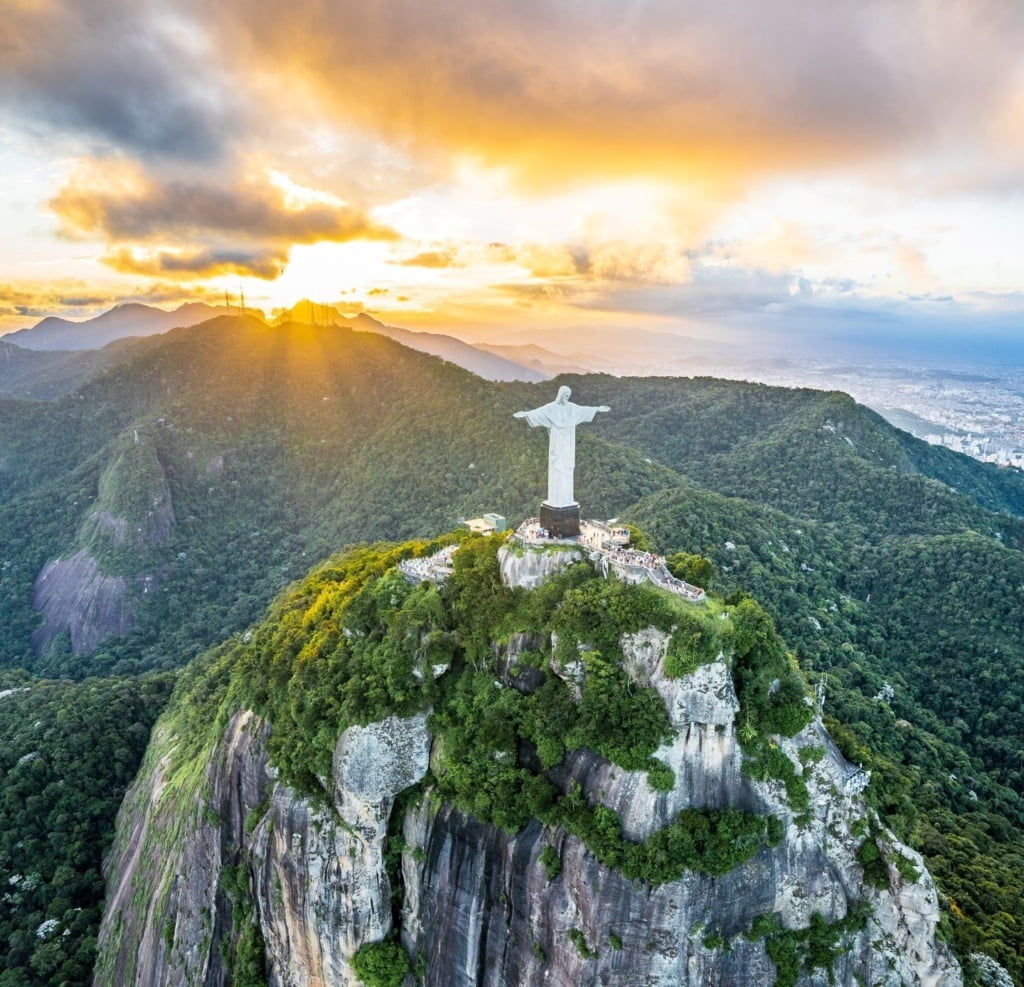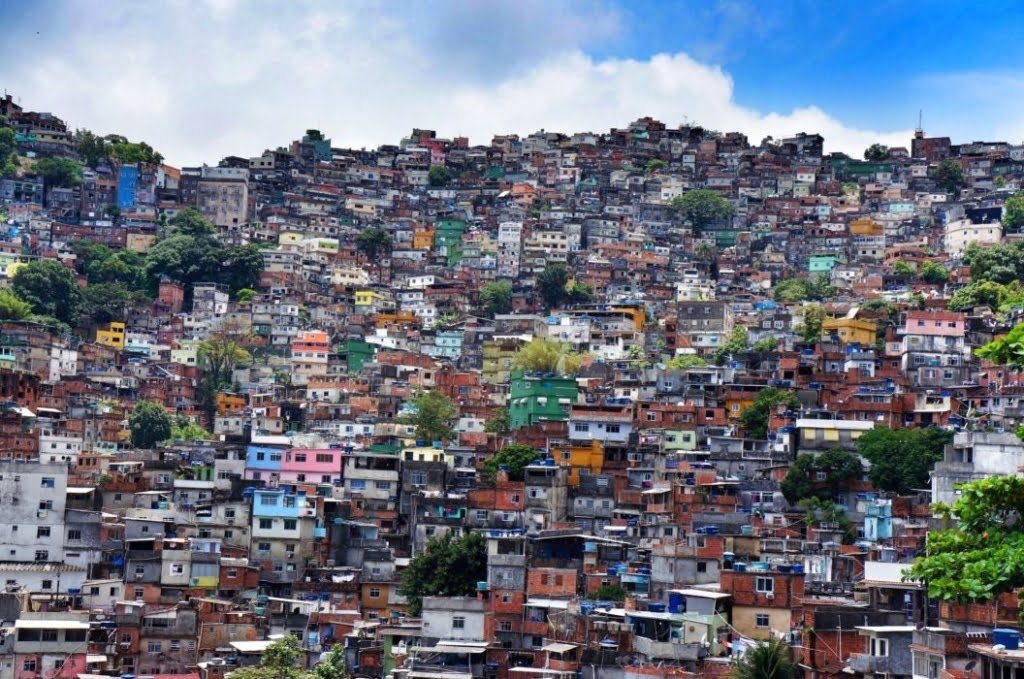It might be common to think of Rio de Janeiro as the Brazilian capital because just about every iconically Brazilian landmark that people know of is located in the city. Rio de Janeiro in fact, used to be the capital until Brasilia was built in a modern and structured way as opposed to Rio de Janeiro’s more eclectic and hilly city laid out. Sitting on the Atlantic coast, Rio de Janeiro was discovered by the Portuguese in 1565 and settled originally as a place to fortify against French privateers who trafficked things like wood and goods out of the country. Those colonial-era outposts and forts still exist in fact. For almost two centuries afterward, Brazil was considered an unimportant outpost in the Portuguese Empire until diamond, gold, and rare earth minerals were discovered and by 1763, Rio became the most important city in the colonies. It became so important to the Portuguese that after Napoleon invaded Portugal, the royal family fled to Rio thus making it the only European capital to be located outside of Europe.
In the modern world, Rio de Janeiro is known for plenty of things. The laid back beach culture was practically invented by the locals, the hills and colorful houses, the unique food landscape, samba music, and much more. While some might connect Rio de Janeiro with being unsafe, the city is perfectly fine for tourists as long as you’re not looking for trouble, you typically won’t find it and most tourist-centric areas are perfectly safe.
Trek up Tijuca National Park
In case you haven’t gathered by now, Rio de Janeiro is an incredibly hilly city, so pack some good walking shoes. This recommendation is a two-for-one with the Tijuca National Park being an attraction and the park hosting another widely known Rio de Janeiro attraction; the statue of Christ the Redeemer.
Tijuca Park is one of Brazil’s national parks and its central location in the middle of the city makes it a pretty unique one in terms of urban green space. The land around the area was once home to some of Brazil’s largest coffee plantations but was effectively rebuilt to be one of the largest forests within a city in the entire world. The forest is pretty massive as well, encompassing over 8,000 acres of land and being home to native tree and plant species as well as animals like capuchin monkeys, colorful toucans, hawks, eagles, and radiant blue butterflies. Other hikers and tourists highly traffic the area, so it’s pretty hard to get lost. Since the park is elevated on a mountain Tijuca National Park offers some of the best views of Rio as well as several waterfalls and even colonial-style houses. Of course, if you’re looking to get even higher up, that’s where the iconic Christ The Redeemer Statue sits.
Visit the Iconic Christ the Redeemer Statue
Located 2,300 feet above the city of Rio de Janeiro is the worldwide recognizable landmark of Christ The Redeemer. Standing on top of Mount Corcovado the statue has been a part of the city’s landscape since the 1930s and took almost a decade to build. The project was mostly financed by contributions from Brazil’s Catholic community and was created by French-Polish sculptor Paul Landowski. The statue itself is about 100 feet tall and weighs about 700 tons. Inside the statue is a chapel where it is fairly common to see weddings and baptisms take place. The Corcovado rail track goes through the Tijuca National Park if you don’t feel like hiking through it and if you’re aiming to see this internationally recognized monument without the crowds, go as early in the morning as possible.

One of the New 7 Wonders of the World, Christ the Redeemer is a must-see while in Rio.
Indulge in some local food at Feira Livre da Glória
Every Sunday morning the Feira Livre da Glória turns into one of the city’s best spots for food and culture. The area is a large spot that aims to promote local food growers and producers in the heart of the city. For the die-hard foodies out there looking to experience something new this place and activity off the tourist trail and the perfect place to grab some cheap and affordable food that’s also fresh. Sample some exotic produce and fruit or indulge in a tasty breakfast of pastels – a meat and cheese stuffed pastry. Order one with a side of sugarcane juice and you have the perfect Brazilian hangover cure.
Grab A Drink at Bar do Gomez
Located in Santa Teresa this bar is one of the best around for several different reasons. The place offers one of the biggest varieties of cachaça (Brazil’s national spirit) around and is a piece of local history with the building being over 100 years old. The original location was the home and business of a Spanish immigrant who opened a grocery here in 1919. While the owner has been long dead, his name still carries on in the legacy that is this bar. While the grocery part is no longer a thing, guests here can indulge in a tapas-style atmosphere with tasty small plates of food like salted cod fritters drizzled in hot sauce or even heartier meals like sandwiches or grilled meat and rice. Wash it down with a frosty cold beer or one of many cachaça’s. Hang out with the locals and get the low down of life in Rio or head on over to one of the many other bars and nightclubs in the area.

Originally opened in 1919, the Bar do Gomez retains much of its historic charm.
Hit the Beaches
It wouldn’t be a trip to Rio without spending a lot of time at the beach. The people of Rio practically invented beach culture. Heading to the beach is not only a pastime here it is practically a religion and there are a few things that you need to know before hitting the sandy Rio beaches. Even the most seasoned beach veteran will love the beaches of Rio. They’re generally very clean, have soft white sand, have regularly cleaned bathrooms, shops, bars, food, and showering facilities. Along with life-savers and police presence, the atmosphere at Rio’s beaches are a true pleasure to be around. That being said there are a few things you need to know. Despite what some foreigners might believe, women don’t go topless but wearing thong bikinis are the norm for women of any age or body type. While on the flip side of that, men generally do not wear speedos, and wearing one will make you stand out, and unfortunately standing out like a tourist can make you a target for theft. So if you want to blend in dress as the locals do. Luckily the beaches are full of vendors selling swimwear for cheap. So now that you’ve got the gist for beach culture where to go? Luckily for you, there are plenty of options.
Copacabana: The undisputed queen of the beaches, Copacabana is the heart and soul of Rio. Stretching over 2.5 miles of sandy white beaches, Copa is a national landmark. Steps away from the beach is the Avenida Atlantica where you’ll find luxury hotels, beachside restaurants, cafes, and centuries-old buildings some of which date back to the colonial era. Copacabana is the most popular of the beaches so expect a mix of locals and tourists flocking here. The beach brings in so many people that it functions as its own economy complete with vendors who will sell you anything from a bathing suit to a grilled cheese sandwich.

Head to Copacabana. White sand. Blue clear water. And you can buy almost anything you want there.
Ipanema: Separated by the Jardim de Ala Canal, Ipanema beach is arguably the number two in iconic Rio beaches. While Copa has more of a tourist and party atmosphere, Ipanema is a little more laid back but still offers the fun of beachside restaurants, cafes, and cultural life. But the boardwalk here also has some other less crowded landmarks like cinemas, art galleries, and museums. There is also an antique market every Sunday, so if you’re looking to get out of the sun for a bit, there is plenty to do.
Ilha Paqueta: To get to this idyllic retreat you have to take a boat, but the trip is worth it. Located in Guanabara Bay Ilha Paqueta is a small island known for its tranquil setting, quiet beaches, and little island bars. If you’re looking to get out of the city without really going out of Rio, Ilha Paqueta makes a cool getaway. The island enforces a strict no-motor rule so getting around the place either done by horseback, foot, or bicycle.
Abricó: If you’re really looking to find a nude beach, then you only have one option. Abricó is Rio’s only nudity permitted beach. Abricó is very quiet compared to the other beaches in Rio so peace and relaxation are what you’ll find here. The beach itself is pretty nice but because it isn’t as popular as the other one and is a little more off the beaten path, you won’t have the same services as you would at the larger more populated beaches.
Go on a Favela Tour
While not for the faint of heart you might think it’s a bad idea to go tour a favela but in recent years there has been a lot of interest in touring Rio’s notorious shantytowns. While the glitz and glamour of Avenida Atlantica and Copacabana beach are fun they do present a side of the city that doesn’t show tourists the whole picture about living in Rio. There are over 700 favelas in the city most of which are located on slopes and hills and almost two-thirds of the city’s residents live in a favela.
Some favelas are amazingly huge with a rich culture, vibrant art, and good-natured people but the truth is that many of them are the homes of organized crime in the city, some of which are so bad that police don’t bother to go in them. All this being said, quite a few agencies are willing to take tourists on walking tours of these neighborhoods. See how a large portion of the city really lives. Interact with the locals and get a glimpse of an authentic look at life here. Rocinha is the largest and more developed favelas and has a longer history of tourism with a lot of local companies offering tours of the area. There is a police presence there but don’t mistake it for being totally safe either.
Favelas are rife with guns and drugs so never go into one alone. If you’re invited to see one do a little research ahead of time. Again, while potentially dangerous a tour of a favela can easily be the highlight of your trip to Rio. If you’re worried about the ethical implication of a favela tour, the money goes into the local economy and can improve the lives of the people living there. Just always make sure you’re going with someone reputable and never go in alone.

To see how many people live in Rio, take a Favela tour. But beware, it is not for the faint of heart.
Catch a Game at Maracanã
While the majority of Rio’s residents are catholic, the real religion here is soccer. The Maracanã stadium is Brazil’s biggest with enough room to seat over 75,000 people. It hosted the opening and closing ceremonies of the 2016 Olympic games and the 2014 World Cup. The stadium is near Copacabana and Ipanema beaches so there’s plenty of tourism in the area along with sports clubs and restaurants. Maracanã is home to Rio’s four biggest clubs; the Flamenco, Botafogo, Fluminense, and Vasco da Gama. Catching a game here in one of the biggest stadiums in South America, in one of the biggest soccer-loving countries in the world is an experience you won’t forget.
Our Final Word
Rio de Janeiro is a beautiful city. It’s old and filled with amazing architecture and is home to some of the world’s best and most iconic beaches. Despite its bad reputation for violence Rio is a great place for a holiday where you can experience the food, the culture, and the outdoors right there in a world-class city.
Related Posts
Exploring the Rich Culture and Natural Beauty of Costa Rica: 5 Intriguing Facts
Costa Rica, a land of captivating beauty and vibrant culture, offers a plethora of intriguing facts to discover. From its lush rainforests teeming with exotic wildlife to its warm and welcoming locals, this Central American gem never fails to amaze. Prepare to be enchanted by its stunning biodiversity, awe-inspiring volcanoes, and delicious traditional cuisine.
Unveiling the Mysteries of the Galapagos: A Must-Visit Destination
“Unveiling the Mysteries of the Galapagos” takes you on an unforgettable journey to one of the world’s most unique ecosystems. Discover the islands’ diverse wildlife, volcanic landscapes, and rich history. This must-visit destination offers an unparalleled adventure for nature lovers and explorers alike. Dive into the Galapagos, where every day is a new discovery.
The Human Connection: Why We Should Care About People We Meet on Our Travels
“The Human Connection” explores the profound impact of human interactions during travels. It emphasizes the importance of embracing local cultures, understanding diverse perspectives, and forming meaningful connections. This post encourages readers to see beyond tourist spots and delve deeper into the heart of the places they visit, through the people they meet.










0 Comments